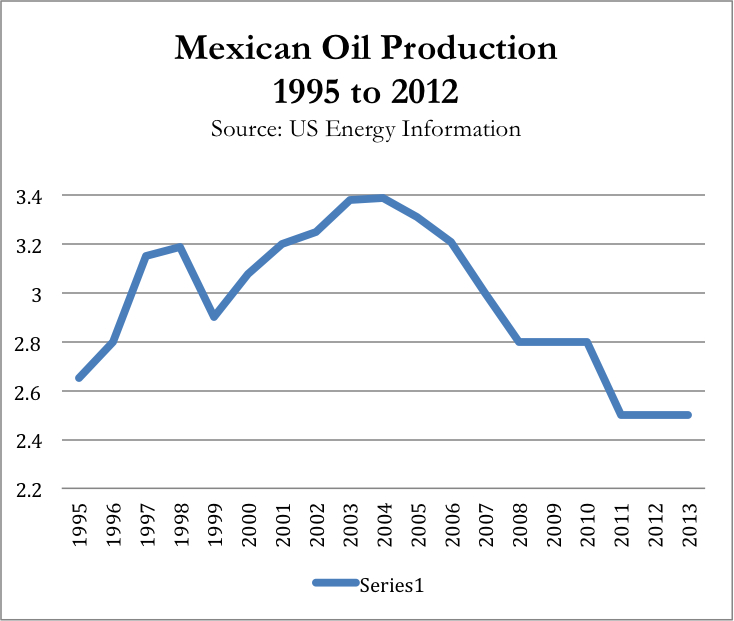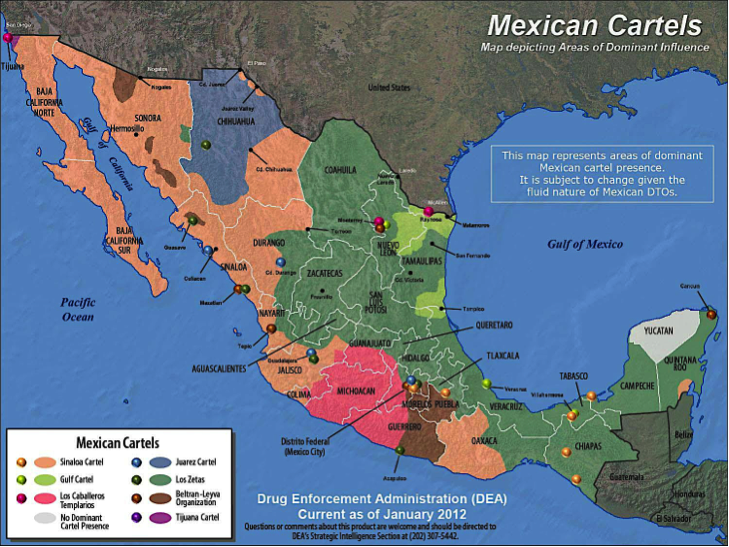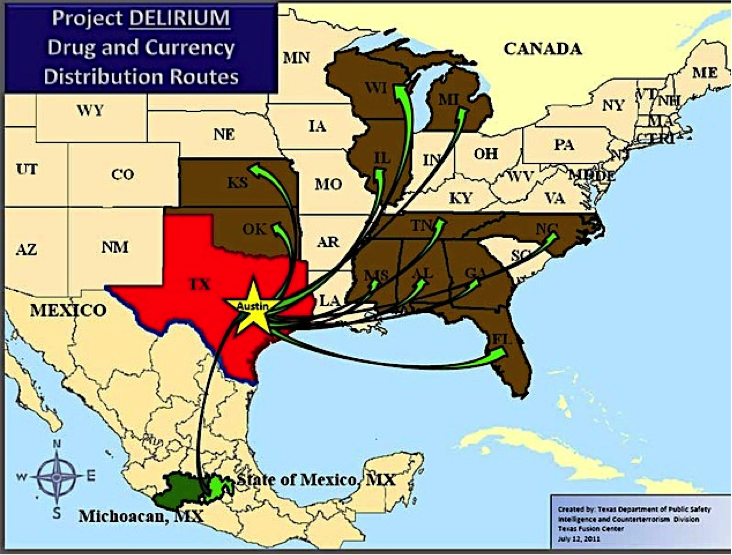Hill Country Law Enforcement Association Thursday, Sept. 26, 2013
Round Mountain, Texas
Border Map
First some geographical and population facts about the border and the several countries that meet along the Texas side of the U.S. Mexico border. I focus upon this 1200 mile section of the 2,000 mile border as in the last two years the level of immigration crossings is highest here and it is also where most trade passes.
Population
| Country | Population | Median Age | |
| Belize |
330,000.00 |
21 |
|
| Costa Rica |
4,500,000.00 |
29 |
|
| El Salvador |
6,000,000.00 |
24 |
|
| Guatemala |
13,000,000.00 |
20 |
|
| Honduras |
8,000,000.00 |
21 |
|
| Nicaragua |
5,600,000.00 |
23 |
|
| Panama |
3,400,000.00 |
28 |
|
| TOTALS |
40,830,000.00 |
23 |
|
| Mexico |
114,000,000.00 |
27 |
|
| United States |
314,000,000.00 |
37 |
|
Trade
U.S./Mexico Surface Trade – Texas Corridor
The State of Texas has a 1,254-mile long border with Mexico. Texas’ multiple border crossings makes it the largest port-of-entry for goods traveling from Mexico into the United States as well as goods heading south from the U.S. into Mexican markets.
The Texas-Mexico auto manufacturing region has emerged over the past decade as the land bridge connecting automakers with plants in Texas, Michigan, Ohio, Wisconsin, Kentucky, and other states of the \American South to the concentration of assembly plants in central Mexico, such as those in León and Toluca and as far south as Puebla. The auto supply chains run north and south, from Mexico to Canada, 24/7. More of the auto industry flow passes through Laredo than any other U.S.-Mexico port.
In 2010, about $114 billion in international freight crossed through Laredo. Nearly half of it was auto-related. The next-largest category, mainly electronic products and components, amounts only to one-fourth the amount of auto freight. Most, 98 percent, of Texas exports go to Mexico and more than 463,000 jobs in Texas and 700,000 in California rely on trade with Mexico.
Texas is responsible for about 44 percent of U.S. exports to Mexico. A large portion of those shipments are destined for maquiladoras, factories along the border that use cheap Mexican labor to assemble components manufactured in the U.S. into final products before sending them back over the border to be sold. In short, the migration of low-skill manufacturing away from America and into Mexico has had some collateral benefits and problems for Texas.
Texas Exports to Mexico
The major exports from Texas to Mexico are agriculture: cattle, pork, chicken, wheat, cotton and other coarse grains. Refined oil products and natural gas are exported to Mexico and about 1/3rd of Texas refined exports go to Mexico
IH 35 Corridor
These trade items move principally north and south by rail and truck on the IH 35 route. Laredo is the world’s busiest land port with a truck crossing every 8 minutes 24/7.
Core of the Mexican Economy
| Export Item | Dollar Amount | Profit Percentage | Profit |
|
$130 billion | 10% | $13 Billion |
|
$185 billion | 8% | $12 Billion |
|
$300 billion | 10% | $30 Billion |
|
$100 billion | 15% | $15 Billion |
|
$50 billion | 80% | $40 Billion |
The reality of the foundations of the Mexican economy is that the two most profitable are the most troubling. Oil exports which fund the middle class in Mexico have grown stagnant since 2005. The other very profitable sector is drug trafficking. Its impact is illustrated by the Cartels and sample efforts such as Project Coronado and Delirium to reduce Mexican presences including command and control operations in the United States. With the immense profits Mexican drug barons look for ways to “wash” the money to make it legitimate. The trials in Austin this year of the Zetas and their quarter horse schemes are only illustrative.
2009 Project Coronado
2011 Project Delirium
2013 Zetas’ Quarter horse Money Laundering
Four Alternative Scenarios For Mexico
A. Collapse in progress
World recession deepens. Oil plays out in Mexico’s top producing fields, Mexico cedes control to private actors over the south and north of the country with 10 million refugees in Mexico from the countries to its south, and 20 million refugees from within Mexico head to the northern cities of Mexico and the United States. Millions will come to Texas alone. Mexico is beset with guerilla bands controlling much of the countryside and several of the larger low-income neighborhoods in Mexico City. Staged attacks on American border cities occur with regular frequency and local police in Mexico are overwhelmed facing cartels that are better organized, funded and equipped and abandon their posts. American border cities are overwhelmed with refugees and violent gangs. American military units are required to defend against armed intrusions from Mexico.
B. American Protectorate
Cartels use hit squads to attack American law enforcement in border cities on both sides. The United States intervenes with military forces as it has done in other countries and creates a protectorate for the Mexican Federal government south to Monterrey, Saltillo and Durango. Wealthy and educated Mexicans move to Texas for safety and call for more American military and police action to defeat cartel armies. The traditional northern Mexican antipathy toward the “chilangos” of Mexico City grows and a process of tying the northern Mexican states closely to the American Southwest accelerates. Leftist and nationalistic mobs burn and sack the American Embassy in Mexico City. The ancient fear of another American invasion of Mexico becomes real and kindles long simmering antipathy toward the north. Norteños from bases in Texas plan to re-take northern cities fallen into chaos and urge U.S. support.
C. Revival of Pax Americana
American economy revives and joint American and Mexican efforts suppress cartel activity with attendant boosts in tourism, maquila employment and domestic growth. America sharply reduces illegal drug consumption. Mexico increases its historical ties with Central America and opens the region to the south to economic growth and channels American technological knowhow through all of Latin America. Mexico curtails the power of its unions and its most wealthy and extends public education to 14 years for all citizens. America provides support for joint educational ventures with American and Mexican universities. The North American continent becomes the model for integrating raw material, labor resources and intellectual creativity in a bursting of prosperity and hemispheric free trade.
D. Reprieve
World economy rebounds. Oil prices rise to $200 a barrel. Mexico permits foreign investments and spins off Pemex, which modernizes engineering, refining and exploration. The rising price of oil removes the labor cost advantage of nations in Asia for manufactured items imported to the United States and Europe. Maquila partnerships and fully domestic manufacturing activity soars in Mexico. Corruption is curtailed and profits soar. Situation stabilizes to a significant degree as the wealth generation exceeds what is loss to corruption. Mexico continues to make progress in developing manufacturing relationships with various foreign companies. Tourism rebounds as the PRI controls press reports of crime.
Adapted from The Dying Elephant-Mexico’s Path to a Failed State ©2013




